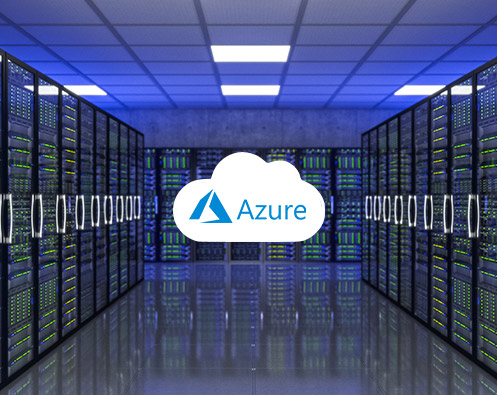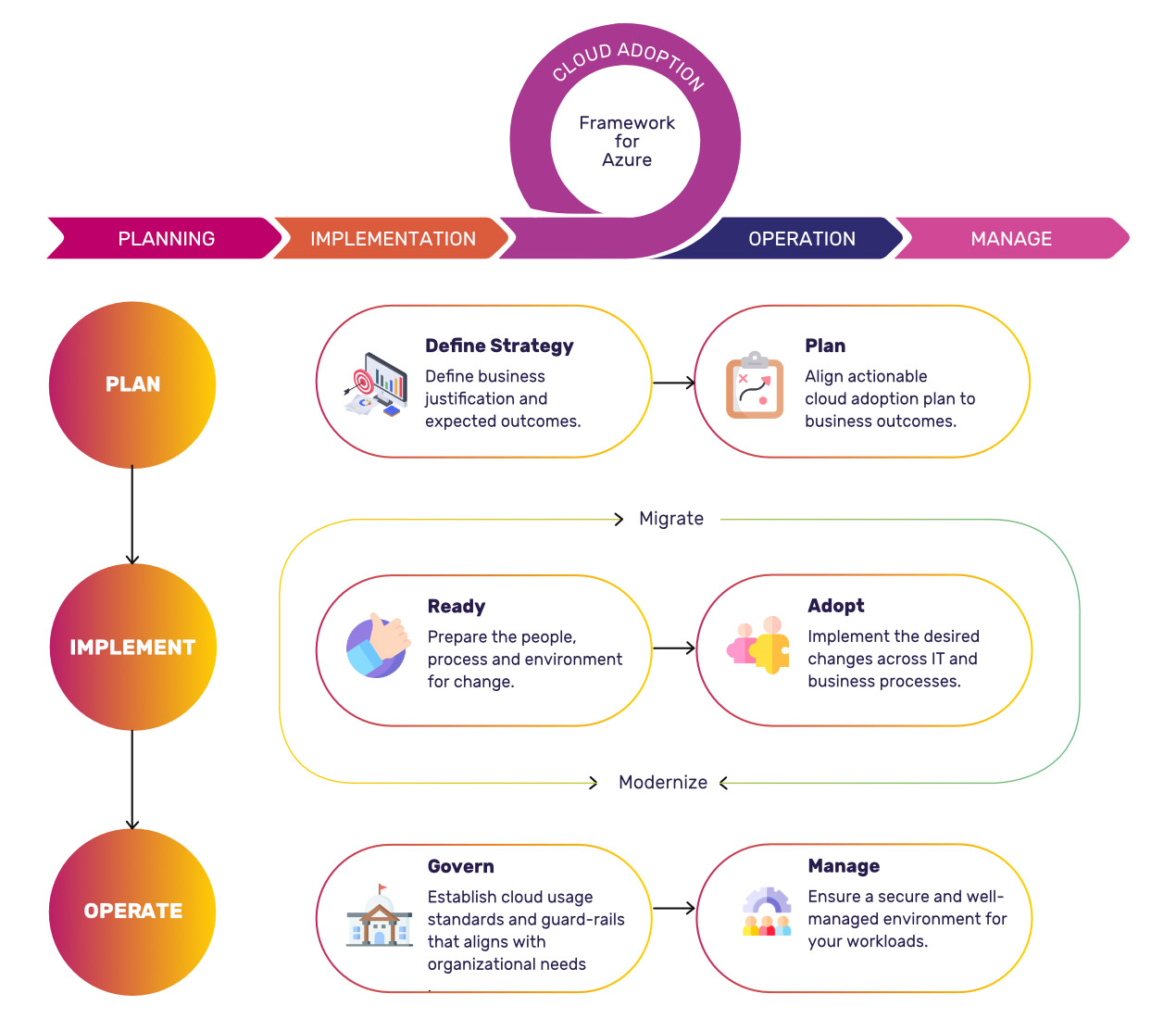
Transitioning your ERP to Cloud
A recent report stated that the average ERP software budget per user is USD 9000. While 13% of the organizations globally upgraded ERP systems in 2019-20, 87% required ERP implementation assistance.

Sign up for a seamless cloud adoption journey with us. Deploy cloud migration solutions to achieve accelerated business results in the digital world.
Cloud migration and adoption technologies are at the center of the digital transformation revolution. Companies embracing digital transformation must embrace cloud solutions to be successful. There are many advantages to adopting the cloud and making use of Cloud migration services. Businesses opt for cloud migration for a range of motivations, while seeking a variety of benefits. These benefits fall into four categories: cost, agility, service quality, and new scenarios.
Korcomptenz is one of the leading Cloud migration service providers that combines a Hyper-Scale cloud offering, a truly hybrid platform, and an Enterprise Level Support for your cloud workloads with Enterprise level SLAs. THE ONLY CLOUD: ENTERPRISE LEVEL, HYPER SCALE, AND TRUE HYBRID. The most common service is ‘lift and shift’ cloud migration services through our Azure Migration Services and AWS infrastructure services (IaaS).
As a Microsoft Gold Partner and AWS Partner, Korcomptenz gives you a competitive advantage with AWS and Azure adoption services, each with its pros and cons, so choosing and collaborating with the right cloud migration service provider like cloud consulting, cloud migration, and more.















The decision for cloud migration involves a complex array of factors that are specific to your organization. Here’s a comprehensive overview to consider before embarking on this transformative endeavor:
Alignment with Business Goals: Before embracing cloud migration, especially Azure migration services, it’s crucial to assess how well it aligns with your business objectives. While cloud adoption can offer advantages such as scalability, cost-effectiveness, and innovation, it must harmonize strategically with your overall business strategy.
Suitability of Applications: Not all applications are equally suitable for migration to the cloud. Factors such as complexity, data sensitivity, and integration needs should be considered. Some applications might be better suited for a hybrid or multi-cloud approach.
Comprehensive Cost Evaluation: Conduct an in-depth cost analysis. While the cloud provides flexibility, costs can accrue if not managed diligently. Compare the expenses of cloud migration against maintaining on-premises hosting.
Meeting Performance Requirements: Evaluate whether your applications can maintain or even enhance their performance in the cloud environment. Factors like latency and data transfer speeds should be thoroughly examined.
Security and Compliance Considerations: Gauge whether your chosen cloud service provider can fulfill your security and compliance prerequisites. The presence of sensitive data and adherence to industry-specific regulations could significantly impact your decision.
Scalability Advantage: If your applications encounter variable workloads, the inherent scalability of the cloud can be a major asset. This capability enables you to pay for resources solely as needed.
Skill Set: Factor in the expertise of your team. Successful cloud migration demands specific skill sets. If your team lacks these proficiencies, collaborating with cloud managed services might prove to be a prudent choice.
Effective Data Management: Determine how your data will be handled within the cloud environment. This involves considerations such as data migration, storage procedures, backup protocols, and strategies for disaster recovery.
Integration Capabilities: If your applications necessitate integration with on-premises systems or other cloud services, assess how easily this integration can be achieved in the cloud context.
Addressing Change Management: The migration of applications isn’t just a technical shift; it also exerts an impact on your organization’s culture and operational processes. It’s important to deliberate on change management strategies to navigate this transition effectively.
Future-Ready Scalability: Adopt a long-term perspective. Will the chosen cloud solution accommodate your future growth? Can you seamlessly introduce new services or expand to different geographical regions?
Cloud migration is a challenging endeavor, presenting challenges even to seasoned experts. This intricate process involves multiple steps that can span up to 120 days for completion.
Predicting the timeframe involves factoring in various variables. Key considerations for most cloud migration projects encompass legacy infrastructure, migration objectives, operational requisites, team expertise, and size.
Limited-Scale Migrations: Smaller initiatives, such as relocating data from a singular server, might extend to approximately two weeks, assuming the absence of integrated services. Additional determinants influencing these endeavors encompass supplementary project prerequisites and the dimensions of your cloud migration team.
Stepping into Medium-Scale Projects: Medium-scale cloud migration projects, encompassing the migration of email systems and digital assets, typically span from two to four months. The benefits of cloud computing become notably pronounced at this level, prompting many enterprises to integrate cloud management services.
Navigating Large-Scale Migrations: Large-scale cloud migrations entail applications and expansive data centers. Undertakings of this magnitude necessitate meticulous strategies and can extend to a full 120 days for completion. Consider engaging professional Azure migration services to navigate these complex undertakings effectively.
Companies choose cloud migration for a variety of compelling reasons that align with their business goals and growth strategies. Below are key factors that drive organizations to undertake this transition:
Scalability: Cloud environments provide dynamic scalability, allowing companies to easily adjust resources based on demand. This flexibility ensures optimal performance during peak periods and cost savings during quieter times.
Cost Efficiency: Cloud migration often results in diminished capital expenses for organizations. They can adopt an operational expense framework, wherein payment is made solely for the resources consumed. This approach eradicates the necessity for initial investments in hardware and infrastructure. Cloud migration often results in diminished capital expenses for organizations. They can adopt an operational expense framework, wherein payment is made solely for the resources consumed. This approach eradicates the necessity for initial investments in hardware and infrastructure.
Flexibility: Cloud platforms, which encompass Azure migration services, offer a diverse range of migration services and deployment models. This empowers enterprises to choose the method that aligns most effectively with their demands. This flexibility empowers them to customize solutions to meet specific requirements.
Innovation: Cloud environments grant access to cutting-edge technologies like AI, machine learning, and analytics. This allows companies to innovate swiftly and experiment with new concepts, unconstrained by traditional IT infrastructure limitations.
Global Reach: Cloud migration services are reachable from everywhere if you have an internet connection. This ensures global association, remote work, and the ability to serve your customers across different regions.
Disaster Recovery: Cloud migration provides disaster recovery solutions. Information is duplicated throughout numerous locations, reducing the hazard of data loss due to hardware or natural disasters.
Agility: Cloud environments facilitate swift deployment and application updates. This agility empowers businesses to rapidly respond to market changes and seize emerging opportunities.
Security: Cloud providers heavily invest in security measures and compliance certifications. Shifting to the cloud often elevates data security, as providers offer advanced encryption, authentication, and access controls.
Reduced Maintenance: Traditional on-premises infrastructure demands ongoing maintenance and updates. Cloud migration transfers these responsibilities to the provider, enabling IT teams to concentrate on strategic initiatives.
Environmental Impact: Cloud migration can contribute to a diminished carbon footprint. Cloud providers optimize resource utilization, leading to energy savings and more resource-efficient operations.
Competitive Advantage: Businesses embracing cloud technology frequently attain a competitive edge by accelerating time-to-market, providing enhanced customer experiences, and maintaining agility in a swiftly evolving business environment.
Cloud migration services possess the capabilities to effectively manage intricate legacy systems and applications, ensuring a smooth and secure transition to the cloud that doesn’t compromise critical business operations. Here’s a breakdown of how they accomplish this:
Thorough Evaluation: The process begins with Azure migration services conducting a comprehensive assessment of your legacy systems and applications. This evaluation delves into identifying dependencies, addressing challenges, and recognizing potential risks. This assessment forms the foundation for a well-structured migration strategy.
Tailored Strategy: Drawing from the assessment, these services develop a tailored migration strategy. This plan charts the methodology for migration, techniques for data transfer, and considerations for application compatibility. The purpose is to make sure a smooth transition doesn’t interrupt your operations.
Data Mapping and Transformation: Migrating data from legacy systems often necessitates adapting it to suit the cloud environment. Cloud services employ advanced data mapping techniques to guarantee precise and consistent data transfer.
Isolated Testing: Before executing the full cloud migration, migration services set up isolated test environments. These environments simulate cloud conditions, enabling rigorous testing of applications and legacy systems. Any issues identified during this phase are addressed to ensure a smooth transition.
Efficient Data Transfer: Azure migration services employ proven methodologies for data transfer, minimizing downtime and data loss during the migration process. Techniques like incremental migration and real-time replication are utilized to ensure data integrity.
Application modernization: In the case of legacy applications requiring adjustments for the cloud, migration services assist in modernization endeavors. This could involve activities like refactoring, rearchitecting, or containerization, enhancing performance and functionality within the cloud environment.
Enhanced Security: Security remains a paramount consideration throughout the migration. Cloud migration services implement robust security measures to ensure that your data remains safeguarded during the entire transition.
Disruption Minimization: These services prioritize minimizing disruptions to critical business functions. Strategies include scheduling migrations during off-peak hours and implementing contingency plans, like rollbacks, to manage unexpected challenges.
Sustained Support: Following migration, Azure migration services provide ongoing support to address any post-migration issues or opportunities for optimization. This ensures your legacy systems maintain peak performance within the new cloud setting.
Data Integrity Validation: Rigorous validation procedures are conducted after migration to verify the accuracy of data and the seamless functionality of applications. This step guarantees that business operations continue unhindered in the refreshed cloud environment.
The cloud migration process places significant emphasis on addressing data privacy and compliance concerns to ensure that sensitive information remains protected and aligned with regulatory requirements. Here’s how the process addresses these critical aspects:
Data Classification and Auditing: Before migration, Azure migration services experts conduct a thorough assessment to classify data based on its sensitivity. This allows for a clear understanding of what data is being moved and helps determine the appropriate security measures. Auditing ensures that data access and usage are tracked and monitored.
Compliance Assessment: Cloud migration services analyze the regulatory landscape relevant to your industry and location. This includes regulations such as GDPR, HIPAA, or industry-specific standards. By identifying compliance requirements, the migration strategy is tailored to meet these standards.
Data Encryption: During cloud migration, data is encrypted both in transit and at rest. Strong encryption protocols ensure that even if unauthorized access occurs, the data remains indecipherable, maintaining its privacy.
Access Controls: Cloud migration platforms provide robust mechanisms for controlling access. Services specializing in cloud migration incorporate role-based access controls, restricting data access to authorized personnel exclusively. This preventive measure ensures that unauthorized individuals are unable to access sensitive information.
Multi-Factor Authentication (MFA): Enhanced security is achieved through the implementation of multi-factor authentication. This necessitates users to provide multiple forms of verification before accessing data, effectively diminishing the possibility of unauthorized access.
Data Residency and Sovereignty: The cloud migration strategy considers the physical location of data centers to ensure compliance with data residency and sovereignty regulations. This prevents data from being stored in regions that might violate local laws.
Vendor Compliance: Reputable cloud providers adhere to stringent compliance standards and certifications. Cloud migration services select providers that align with the necessary compliance requirements, ensuring that data is stored in a secure environment.
Data Masking and Anonymization: For certain use cases, cloud migration services employ techniques like data masking or anonymization. This allows for testing and development using realistic data without exposing sensitive information.
Regular Auditing and Monitoring: Following the migration process, there is a consistent practice of ongoing monitoring and routine audits. These efforts are aimed at detecting and rectifying any possible vulnerabilities or deviations from compliance benchmarks. This proactive strategy plays a pivotal role in upholding the integrity of data privacy.
Data Retention and Deletion Policies: Cloud migration services establish data retention and deletion policies to ensure that data is retained only for the necessary duration and is properly disposed of when no longer needed.

A recent report stated that the average ERP software budget per user is USD 9000. While 13% of the organizations globally upgraded ERP systems in 2019-20, 87% required ERP implementation assistance.

Cloud Migration has become an integral part of digital transformation. It is the process of migrating databases, applications, and IT resources from on-prem to cloud.

Moving to the cloud simply means that instead of investing on large servers in your office you rent this through a third party cloud provider, making your capex (capital expenditure) and Opex (operation cost) with respect to infrastructure become zero.
| Cookie | Duration | Description |
|---|---|---|
| cookielawinfo-checkbox-analytics | 11 months | This cookie is set by GDPR Cookie Consent plugin. The cookie is used to store the user consent for the cookies in the category "Analytics". |
| cookielawinfo-checkbox-functional | 11 months | The cookie is set by GDPR cookie consent to record the user consent for the cookies in the category "Functional". |
| cookielawinfo-checkbox-necessary | 11 months | This cookie is set by GDPR Cookie Consent plugin. The cookies is used to store the user consent for the cookies in the category "Necessary". |
| cookielawinfo-checkbox-others | 11 months | This cookie is set by GDPR Cookie Consent plugin. The cookie is used to store the user consent for the cookies in the category "Other. |
| cookielawinfo-checkbox-performance | 11 months | This cookie is set by GDPR Cookie Consent plugin. The cookie is used to store the user consent for the cookies in the category "Performance". |
| viewed_cookie_policy | 11 months | The cookie is set by the GDPR Cookie Consent plugin and is used to store whether or not user has consented to the use of cookies. It does not store any personal data. |